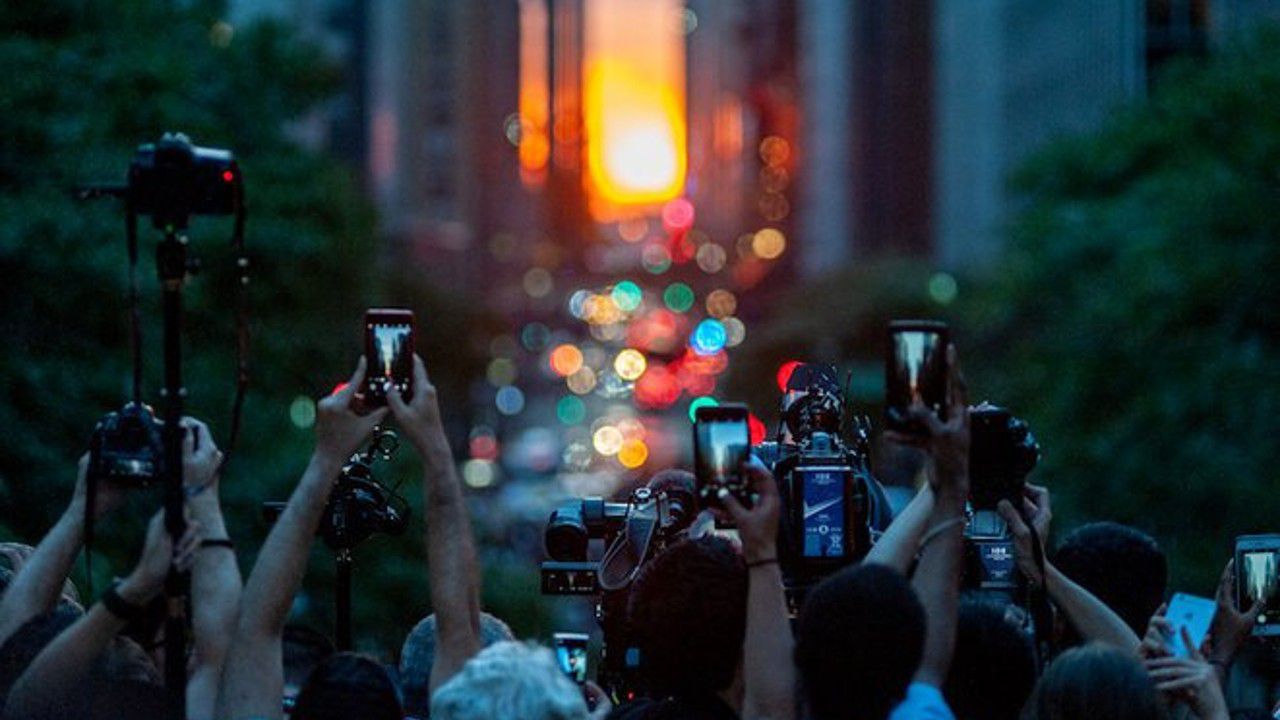Blood moons? Old news. Lunar eclipses? To some observers, frankly un-spectacular. Aurora borealis? Good luck spotting that. If you're in the market for a celestial phenomenon that really makes its presence known in New York City, there's one word you should have on the tip of your tongue: Manhattanhenge.
Also known as the Manhattan Solstice, Manhattanhenge occurs when the sun comes into perfect alignment with parts of the city's street grid for a few blissful summer evenings. It happens every year around late May and mid-July, twice with a full sun and twice with a half sun, weather permitting. ("Full sun" and "half sun" refer to how much of the solar disk is visible above the horizon.)
"It's perfectly framed by the concrete jungle of New York City — I like to call it 'astronomy in your face,'" said Dr. Jackie Faherty, an astrophysicist at American Museum of Natural History (AMNH) who has become the museum's henge-whisperer. "Manhattanhenge is the event of the summer for the celebration of astronomy."
It's an ideal NYC activity, whether you're interested in grabbing a sunset selfie with Helios' avatar behind you, or you just want to soak in the scene as locals and tourists thrust their iPhones toward the sky and jockey for position in the middle of 42nd Street as if they were extras from World War Z.
According to Faherty, it's beloved because it's an epic sunset happening at a time of year when New Yorkers are already flocking outdoors and looking for any reason to stay outside. It's also, as with everything related to sunsets, romantic, and provides a unique photo opportunity for our social media age. (Cityhenges also happen in other urban areas on a grid, including Chicago, Toronto and Montreal.)
"It is a fantastic picture with the sun lighting up the canyons of New York City, and those beautiful golden light hues of red and yellow and orange," Faherty said. "And so it becomes a special bonding moment for New Yorkers and visitors to the city."
You can find this year's dates, which were announced by MTA Away, below:
Manhattanhenge 2022 Dates
- May 29th, 8:13 p.m. (Half Sun)
- May 30th, 8:12 p.m. (Full Sun)
- July 11th, 8:20 p.m. (Full Sun)
- July 12th, 8:21 p.m. (Half Sun)
While the observable phenomenon goes back as long as Manhattan has had a grid, the actual term Manhattanhenge was first coined in the late 1990s by Neil deGrasse Tyson when he was working as an astrophysicist at the Hayden Planetarium at AMNH.
"He started to promote it as director of the planetarium, and as an homage to Stonehenge, which is probably the most famous henge or dedicated structure to a solar position," explained Faherty, AMNH's senior scientist in the Department of Astrophysics. "He decided that Manhattan gets to have its own henge."
Faherty started working at the museum around 2002, and despite Tyson spreading the info about Manhattanhenge on his "Starstruck" email list, it took several years to take off. "We'd get the emails from the director, and I was always like, 'Oh, yay!'" Faherty said. "And I would invite my friends, we would go outside and look for it, and no one was out there. This was not a popular phenomenon yet — it had not spread."
She took it upon herself to start doing public programs on it at AMNH to bring more attention to the phenomenon. And as Tyson's fame grew, more and more people "started to pick up on it that way. Now it is what it is. It went viral. As an astronomical phenomenon might, this one went viral."
Around a decade ago, Tyson passed the Manhattanhenge baton to Faherty, who now calculates its dates and times each year. It's become one of her favorite parts of the job because of how much joy it brings to the city.
"You get people that are so friendly with each other all of a sudden," she said. "New Yorkers aren't known for talking to each other on the street, but this is a very curious city. So you could be out on a Manhattanhenge sunset moment, and cars are stopping and people are in the middle of the street, and everybody's just like, 'What's going on?' And you unify over that and chat, and that is beautiful and fun. You can learn something...and you can have a good conversation."
Faherty says there are tons of places in the city to watch the phenomenon, from 14th Street up to Washington Heights. She notes that despite the borough's symmetry, you should be mindful of things that break the grid and could get in the way of your view, like hills, buildings or Central Park. You may want to find the widest street possible to really get the full effect, but any street that has buildings you love will suffice.
Her top spots to view it include 145th Street (close to Broadway), 72nd Street, and 42nd Street, which remains the most popular spot for a reason. On 42nd Street, she particularly recommends either going to the Tudor City overpass or heading to Pershing Square by Grand Central — the latter of which technically isn't legal because people end up blocking the taxis, but is a "super fun" spot always filled with professional photographers. She adds that Gantry Plaza State Park in Long Island City gets pretty great views as well.
And even if it's raining or overcast on the Manhattanhenge days, that doesn't mean you're out of luck. There'll be tons of gorgeous sunsets to witness between May 29th and July 12th because of what she has termed the "Manhattanhenge effect."
"The effect days can be just as gorgeous," she said. "Because what's happening between those two days is that the sun is still crossing your grid, it's really low in the sky. So you're in the golden hour, you're in that same moment where the beautiful sun rays are close to the horizon, and they're lighting up the canyons in yellows and oranges."
Because I am only human and not above the occasional attempt at capturing mother nature's je ne sais quoi on my phone, here are some tips on how to best photograph a sunset with your iPhone. And if you've never caught Manhattanhenge before, Gabe Elder made the video below showing the crowds of camera-emboldened onlookers in all their awkward glory at the Tudor City overpass in 2018.
PhoneHenge from Gabe C Elder on Vimeo.
To support the reporting and non-profit journalism by this partner, visit here.





